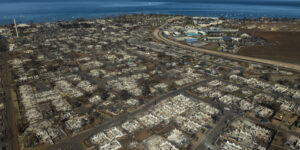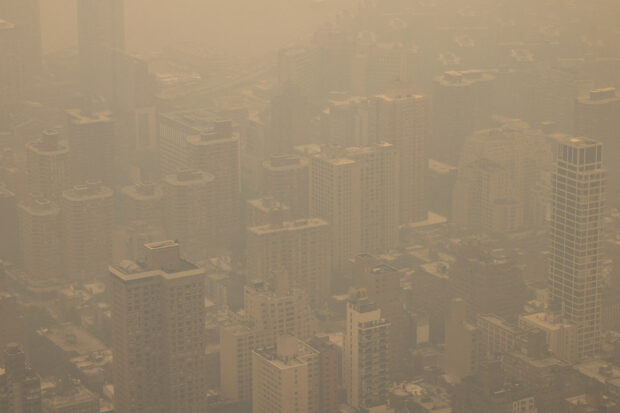Poor air quality and rising costs in metro areas are driving residents away, while places with low risk are gaining residents, according to a new report from online real estate broker Redfin.
Home prices in high-risk metros are 65 percent higher than prices in low-risk metros.
In 2021-2022, 1.2 million more people moved out of than into U.S. metros facing high risk from poor air quality—more than double the net outflow of the prior two years, the analysis found.
Meanwhile, low-risk metros saw 1 million more people move in than out—nearly double the net inflow of the prior two years.
Redfin analyzed domestic migration data from the U.S. Census Bureau and air quality risk scores from First Street.
First Street assigns nearly every U.S. home a risk rating: minimal, minor, moderate, major, severe or extreme.
For this report, “high risk” metros are those where at least 10 percent of properties fall into the major, severe or extreme categories, and “low risk” metros are those where less than 10 percent of properties fall into those categories.
First Street’s rating system is based on the number of poor air quality days expected annually today and in 30 years. It includes two common pollutants: particulate matter (PM2.5), often resulting from wildfire smoke, and ozone (O3), which develops when pollutants react with heat/sunlight.
“Deciding where to live is all about prioritization. With housing costs hovering near their record high, the top priority for many homebuyers is getting a good deal,” said Redfin Chief Economist Daryl Fairweather. “Even when homebuyers do consider climate change, poor air quality often isn’t top of mind because it’s not as visibly destructive as hazards like flooding and fires. But as the dangers of climate change intensify, we will likely see more people factor air quality and other disaster risks into their decisions about where to settle down.”
High-risk metros are concentrated in expensive Western states like California, where wildfires have caused considerable smoke in recent years.
The median home sale price in high risk metros was $563,710 as of December, 65 percent higher than the $341,483 median sale price in low risk metros, the report found.
A Redfin-commissioned survey fielded in May-June found that 9 percent of recent U.S. home sellers cited concerns about climate change as a reason for their move. Other reasons were more common. The top three answers were more space (31 percent), proximity to family (24 percent) and getting a better deal on a home (20 percent).
The number of poor air quality days on the West Coast surged by as much as 477 percent between 2000 and 2021, in large part due to wildfire smoke, according to a First Street analysis of data from the Environmental Protection Agency (EPA).
The Biden administration recently tightened standards for deadly air pollution, targeting PM2.5, which comes from factories and power plants in addition to wildfires.
An estimated 14 million U.S. properties (about 10 percent of all properties) are estimated to have at least a week of poor air quality per year due to PM2.5 today, with nearly 6 million facing two weeks, Redfin stated.
Some places grapple with more.
Fresno, Calif., is expected to have over two months of poor air quality in a bad year under current environmental conditions, and more than three months 30 years from now, primarily due to wildfire smoke.
The West Coast has seen scores of people move out in recent years, and while that’s partly due to wildfires and smoke, the region’s high cost of living is likely the primary driver.
There are 13 major U.S. metros where over 85 percent of homes face high risk from poor air quality, Redfin found.
All are located in the West, with nine in California and the rest in Washington, Oregon and Idaho.
“Over two-thirds of those metro areas saw more people move out than during 2021-2022, and 3 percent of homes for sale across those metros last year were affordable for the typical local homebuyer, on average’, the report noted.
There are 57 major metros where no homes face high risk from poor air quality, the analysis found.
Nearly all (93 percent) are located outside of the West, and 54 percent saw more people move in than out in 2021-2022.
Homes for sale across those metros last year were affordable (19 percent) for the typical local homebuyer.
“Dense American cities have some of the worst air quality, but not everyone can actually afford to leave—even if the city they live in is expensive,” Fairweather said. “If you work remotely, it’s often easy to chase greener pastures. But if you’re in a line of work that requires you to clock in in person every day—and those jobs often pay less—you may not have the means or flexibility to relocate.”
Washington state is plagued by both poor air quality from wildfires and exorbitant housing costs.
In the Seattle metro area, where 100 percent of homes face high risk from poor air quality, Redfin found that 55,092 more people moved out than in during 2021-2022, reversing a trend from 2019-2020, when 2,510 more people moved in than out.
At $750,000, Seattle has the eighth highest median home sale price among major U.S. metros, according to the online brokerage firm. Just 3 percent of homes for sale last year were affordable for the typical local buyer, down from 5 percent in 2022.
Pierce County, Wash., which is just south of Seattle and includes both the city of Tacoma and Mount Rainier National Park, is expected to post the nation’s largest increase in poor air quality days (43 days) over the next three decades mostly due to PM2.5 pollution, the report stated.
The Tacoma metro area saw more people move out than in during 2021-2022, the data showed, a reversal from the prior two years, amid a surge in home prices.
Fairweather left Seattle in 2020 to escape wildfire smoke and moved to Wisconsin, a state free from smoke for the first few years she was there, but last June was inundated with smoke from the Canadian wildfires.
“There’s no such thing as a climate haven,” Fairweather said. “Climate change is making its mark everywhere on Earth. The Midwest may be protected from sea level rise, but it’s still vulnerable to storms, heat waves, drought and now smoke. The best thing homeowners can do is be prepared: Do your research on which climate dangers impact your area and what investments you can make to insulate your family and home from those risks.”
Wildfires aren’t the only cause of bad air quality in the West.
Los Angeles is also at risk from O3. Los Angeles County is expected to have three weeks (21 days) of orange+ air quality this year due to O3—the third highest in the U.S.—and 27 days by 2054, according to data estimates.
The Los Angeles metro area saw 337,757 more people move out than in from 2021-2022, the second highest net outflow in the country (partly due to population size) and is up from a net outflow of 211,756 during the prior two years.
Los Angeles is the fifth most expensive metro for U.S. homebuyers, according to Redfin, with a median sale price of $850,000.
Other metro areas that saw the highest net in-migration in 2021-2022 are Phoenix, Dallas, Tampa, Austin, San Antonio and North Port, Florida.
In Dallas, 100 percent of the homes fall into First Street’s minimal, minor or moderate risk categories.
In terms of number of fires, Texas ranked highest in 2022, and “the state has grappled with both extreme heat and extreme cold in recent years”.
Phoenix is dealing with an impending water shortage and Tampa and North Port residents are concerned with flooding, storms and dwindling insurance coverage options.
A separate Redfin analysis found that the most flood-prone U.S. counties saw 384,000 more people move in than out in 2021 and 2022—a 103 percent increase from the prior two years—as high risk places like Florida exploded in popularity. Flood-prone metros are often relatively affordable, Redfin stated, unlike many of the metros endangered by unhealthy air quality.
(AP Photo/Yuki Iwamura)



















